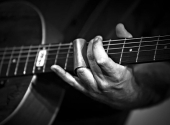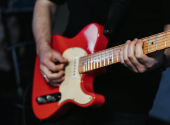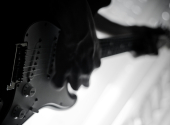
(Un)usual Guitar Techniques #2: Volume knob
In the second episode of our series on guitar techniques, we will take a look at the volume control on the guitar. This seemingly inconspicuous knob is used by most of us, as the name suggests, to turn the guitar up and down, for example, if we're not playing a part of a song and don't want to risk accidental strum or feedback. But there's much more potential here to enrich your solo and rhythm playing.
The name "volume knob" is actually somewhat inaccurate, because along with volume, this knob can also control the amount of distortion or tone colour, depending on the type of guitar. Thus, right on the guitar, you may discover a powerful tool that allows you to switch between clean and distorted sound and change its quality. We'll also focus on a technique called "violining" and how the volume control works.
First, a little bit of physics
Under the plastic knob, labelled VOLUME is a potentiometer that continuously changes the resistance of the signal coming from the pickup. When turned to zero, all signal from the pickup is grounded. When turned to the highest volume, on the other hand, the maximum resistance gets in the way of the signal and most of the signal from the pickups heads to your amp. Why most of the signal? As we know, the electrical signal seeks the path of least resistance, yet some of the signal will always head straight to the ground despite the higher resistance. This is especially true for high frequencies.
The most common volume potentiometer values are 250k and 500k ohms. The higher value puts less load on the pickup output, and therefore less highs leak through the potentiometer to the ground. This is best illustrated by Strats with naturally higher treble single-coil pickups that use 250k potentiometers. These will leak more treble to the ground than the 500k potentiometer used in, for example, a Les Paul with humbuckers. This is because humbuckers have a darker sound, so it is desirable to preserve as much treble as possible.
Find your "sweet spot"
As I mentioned in the introduction, the guitar volume knob is undoubtedly worth paying attention to. This is because it's not a classic on-off switch, but offers a smooth transition between zero and full signal. Take the following lines with a pinch of salt, as it all depends on your type of instrument, guitar, pickups... Nevertheless, especially with tube amps, if you increase the distortion and volume on the amp and decrease the volume on the guitar, you will achieve an almost pure sound at a certain point – usually just before you completely turn the guitar down.
The "almost" is significant. It is a qualitatively completely different sound than when you play a quiet clean sound straight from the amp. By "warming up" the tubes a bit more, you get a richer, denser sound. This quality then translates into that pure tone, which remains saturated and retains some of the energy that the boosted tubes deliver.
Try the following procedure: plug your guitar into an amplifier and turn up the volume until you start to feel the saturation of the tone. Actually, turn it up to the point where you're a little uncomfortable. Now turn the volume knob on the guitar back to the spot where the tone clears again. And here you are at exactly the right point. Keep making small adjustments until you feel like you're holding a dragon on a leash. You want to be able to either release it or tame it to your liking.
Guitar... or violin?
Another technique that uses the volume knob is so-called violining. If you add volume at the moment you strike the string, or just after, you give the tone a slow onset that resembles the resonant sound of a violin or wind instrument. The success of this technique depends quite a bit on the type of guitar, of course, because not all instruments have a volume knob close enough for you to strum with the same hand and control the volume with your pinky. A typical instrument for violining is the Stratocaster, especially in the hands of Jeff Beck, who has refined this technique to perfection.
Even if your guitar has the volume knob in the right place, be prepared for this technique to take a bit of practice and your first attempts will probably sound quite clumsy. Synchronising a strike on a string and simultaneously turning the volume knob to a position where the tone sounds just right is not something you'll nail on the first try. Still, it's worth trying and persevering, because the sound you get from the guitar this way is unlike any other playing technique and it will add a totally unique element to your expressive register. Listen to the first few minutes of the following solo and judge for yourselves.
Where to get inspired?
Many well-known guitarists work with the volume knob from time to time in their solos, but some have incorporated it into their "signature sound", or the distinctive sound by which they are easily recognisable. Among them, Jeff Beck, Steve Morse, Brian May and Derek Trucks stand out.
Jeff Beck was undoubtedly one of the most expressive guitarists in history and his absolute control of tone is legendary. One of the tools he used to achieve this control was precisely the fiddling with the volume knob, sometimes literally on every note. Thus he masterfully achieved crystal clear tones, only to have the guitar sharply "bark" or "growl" the very next moment. It's also worth remembering that Jeff used a very simple stage setup – basically consisting of his Strat, a wah-wah pedal and a 50W Marshall head. All the richness of the tones comes from the perfect use of all the controls on the guitar.
Brian May is a guitarist with a very specific sound, due both to his self-made guitar and the fact that he used a six-penny coin instead of a pick. Using a coin as a pick requires a very soft strike and therefore more amplification of the instrument. Brian then fine-tunes the exact volume nuances by using the volume knob on the guitar.
At first listen, Derek Trucks impresses with his incredible slide guitar technique, but on closer inspection, it also includes precise volume control. Derek is constantly moving seamlessly between bright clean tones and a thick solo sound. He uses two ways to do this. First, he adjusts the volume knob and makes small changes to keep the tone where he wants it. The second way is by adjusting his attack with both the slide and his right hand. The harder he strikes, the more the amp is able to respond immediately.
To conclude, we should add that a great alternative to the volume control can be a volume pedal, which you plug into the beginning of your pedal board, or right behind the guitar. As well as allowing you to incorporate volume work into your solos without having to bend your pinky finger, it's also an easy way to prevent unwanted sounds when changing guitars or tuning your instrument.
But if you don't have the interest or finances to add more pedals, try exploring the possibilities offered by a miniature effect built right into your guitar. From easily switching between clean and boosted solo sounds to controlling tone colour and interesting sound effects, the volume knob is a well-hidden secret worth uncovering.
If you have found an error or typo in the article, please let us know by e-mail info@insounder.org.





